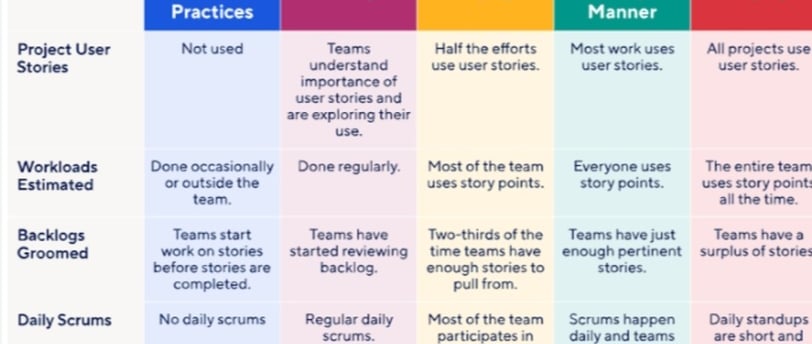Annual Goals for Agile Roles at Different Maturity Levels
A complete picture..
Roopesh Yogiputr Mathur CTO AgileDevOps Smart Management Consultancy
2/28/20243 min read


In organizations that adopt Agile methodologies and the Scaled Agile Framework (SAFe), various roles play a crucial part in ensuring successful implementation and continuous improvement. These roles include Scrum Masters, Release Train Engineers (RTEs), Solution Train Engineers (STEs), Agile Coaches, and Enterprise Agile Coaches. Each role has specific responsibilities and goals that align with the organization's Agile and SAFe maturity levels.
1. Scrum Masters
Scrum Masters are responsible for facilitating the Agile process within their teams and ensuring adherence to Scrum principles. Their annual goals may vary based on the organization's Agile maturity level:
Beginner Level:
- Facilitate daily stand-up meetings, sprint planning, sprint reviews, and retrospectives.
- Help the team understand and implement Scrum practices.
- Promote collaboration and self-organization within the team.
Intermediate Level:
- Coach the team on Agile best practices and continuous improvement.
- Foster a culture of innovation and experimentation.
- Identify and address any impediments or bottlenecks that hinder team progress.
Advanced Level:
- Mentor other Scrum Masters in the organization.
- Drive Agile transformation initiatives.
- Establish metrics to measure team performance and identify areas for improvement.
2. Release Train Engineers (RTEs)
RTEs play a crucial role in coordinating Agile Release Trains (ARTs) and ensuring alignment across multiple teams. Their annual goals may include:
Beginner Level:
- Facilitate ART events, such as Program Increment (PI) Planning and Inspect and Adapt workshops.
- Coordinate dependencies between teams and resolve conflicts.
- Monitor and report on the progress of the ART.
Intermediate Level:
- Improve the efficiency and effectiveness of PI Planning and other ART events.
- Collaborate with Product Management to prioritize and manage the ART backlog.
- Identify and implement tools and practices to enhance ART coordination.
Advanced Level:
- Mentor and coach other RTEs in the organization.
- Drive continuous improvement across the ARTs.
- Contribute to the overall Agile transformation strategy.
3. Solution Train Engineers (STEs)
STEs focus on aligning multiple Agile Release Trains (ARTs) within a Solution Train. Their annual goals may include:
Beginner Level:
- Facilitate Solution Train events, such as Solution Demo and Solution PI Planning.
- Coordinate dependencies and integration across ARTs within the Solution Train.
- Ensure effective communication and collaboration between teams.
Intermediate Level:
- Optimize the flow of value across the Solution Train.
- Identify and address systemic impediments that impact multiple ARTs.
- Foster a culture of continuous improvement within the Solution Train.
Advanced Level:
- Mentor and coach other STEs in the organization.
- Drive alignment and coordination across multiple Solution Trains.
- Contribute to the development and implementation of the organization's Agile strategy.
4. Agile Coaches
Agile Coaches play a crucial role in guiding teams and organizations in their Agile journey. Their annual goals may include:
Beginner Level:
- Provide guidance and support to Agile teams.
- Conduct Agile training and workshops.
- Help teams adopt Agile practices and principles.
Intermediate Level:
- Coach teams on advanced Agile concepts and frameworks.
- Collaborate with leaders to create an Agile culture.
- Identify and address organizational impediments to Agile adoption.
Advanced Level:
- Mentor and coach other Agile Coaches in the organization.
- Drive Agile transformation at the organizational level.
- Contribute to the development of Agile best practices and frameworks.
5. Enterprise Agile Coaches
Enterprise Agile Coaches focus on scaling Agile practices across the entire organization. Their annual goals may include:
Beginner Level:
- Assess the organization's Agile maturity level and identify areas for improvement.
- Define Agile transformation strategies and roadmaps.
- Establish metrics to measure the success of Agile initiatives.
Intermediate Level:
- Coach executives and senior leaders on Agile leadership principles.
- Drive organizational change and create an Agile mindset at all levels.
- Establish Communities of Practice to foster knowledge sharing and collaboration.
Advanced Level:
- Mentor and coach other Enterprise Agile Coaches in the organization.
- Influence and shape the organization's Agile strategy.
- Contribute to the Agile community through thought leadership and speaking engagements.
It's important to note that the goals mentioned above are general guidelines and can be tailored to specific organizational needs and Agile maturity levels. Additionally, these roles often require continuous learning and staying up-to-date with the latest Agile practices and frameworks to effectively fulfill their responsibilities.
In conclusion, setting annual goals for Scrum Masters, RTEs, STEs, Agile Coaches, and Enterprise Agile Coaches should align with the organization's Agile and SAFe maturity levels. These goals should focus on improving team collaboration, driving continuous improvement, and fostering an Agile culture throughout the organization.
